Alfa Romeo 4C: <b>car review</b> | Martin Love | Technology | The Guardian |
- Alfa Romeo 4C: <b>car review</b> | Martin Love | Technology | The Guardian
- Singapore Plans Driverless <b>Vehicles</b>, But You'll Have to Share | MIT <b>...</b>
- Tesla Targeted By Rivals, Fuel-Economy Rule <b>Review</b>, Millennials <b>...</b>
- A Prototype Battery Could Double the Range of Electric <b>Cars</b>
- Fiat Panda 4x4: <b>car review</b> | Martin Love | Technology | The Guardian
| Alfa Romeo 4C: <b>car review</b> | Martin Love | Technology | The Guardian Posted: 20 Dec 2014 10:00 PM PST Red arrow: the Alfa Romeo 4C is a proper headturner. Price £45,000 Sometimes the word "driving" just isn't enough to describe the visceral, elemental, sense-tingling, skull-popping overload of… well, driving. But then along comes a truth-seeking missile of a vehicle that reminds you just what an incredible experience driving a car can be. Alfa Romeo's exquisite new 4C – a small, two-seat, rear-wheel-drive sports car – puts performance and pleasure front and centre. As it hugs each bend, sweeps down every straight and surges up every rise it reminds you how alive a car can make you feel… In many ways, the 4C is the car Alfa Romeo – and fans of Italian sports cars – have been waiting for. Its voluptuous curves coupled to the promise of pure driving nirvana have the task of knocking the historic brand out of reverse and steering it back to profitability and desirability. It'll do this by unlocking the cash-rich markets of America and China. And early signs are very promising. 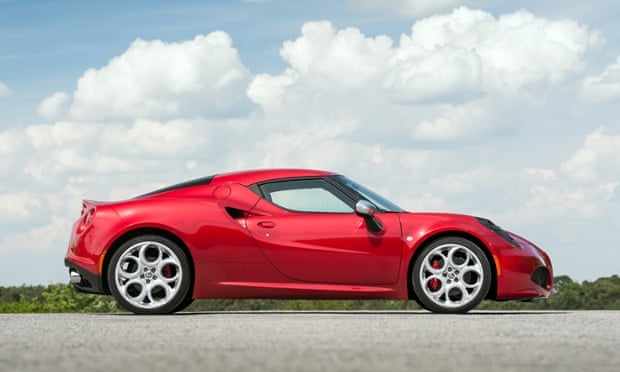 Smooth operator: curves and dramatic air intakes make the 4C a feast for the eyes. Smooth operator: curves and dramatic air intakes make the 4C a feast for the eyes. It was unveiled to a drooling public at the 2011 Geneva motor show and went from concept to reality in just 28 months – a process that usually takes at least five years. Inspired by the legendary 1967 Alfa Romeo 33 Stradale, the 4C was designed and engineered by Alfa's in-house team, with the actual building of it is being done by Maserati at its Modena factory. So, it's a proper Italian job. Considering the heavy lifting expected of it, the 4C is a sprightly bantamweight, tipping the scales at just 895kg. Its mighty engine is positioned right behind you. It sits so close to your back that it feels like it's breathing down your neck. Turn round and you'll glimpse it through a narrow lepers' squint of a window, as if it's some rare exhibit. The power from this all-aluminium 240hp 1,750cc turbo engine is astonishing. You'll hit 62mph from a standing start in 4.5 seconds and you can then crack on up to a top speed of 160mph. 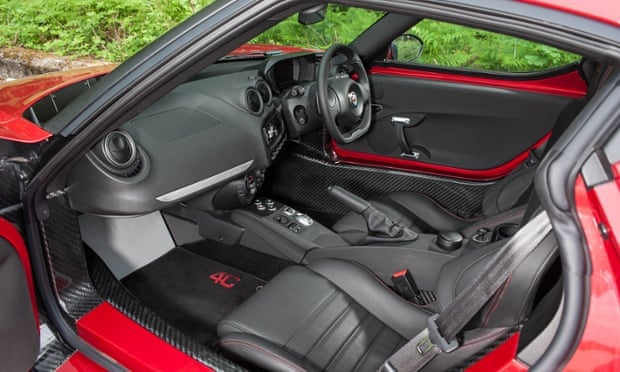 Inside story: the snug cockpit of the 4C. Inside story: the snug cockpit of the 4C. With its swirling bodywork and tantalising shell-like air intakes, the 4C is molto bello. But, like those things that require a sophisticated palate to truly appreciate – I'm thinking whisky, Wagner, maybe a little light bondage – your first taste of the 4C might be a bit painful. Its doors are heavy and climbing in is difficult, while getting out is hilarious – I ended up crawling on to the road at one point. If you have a bad back or weigh more than 14st forget it. The materials used inside are borderline crap. That's not a technical word. The plastics would barely make the grade at the Little Tikes factory. The radio is dismal; rear visibility is nonexistent; the boot is pathetic. And the horn! It sounds like an apologetic parp escaping from an old vicar as you kneel at the altar rail. But… and it's a huge BUT… turn the key and, boosh, the metamorphosis begins. 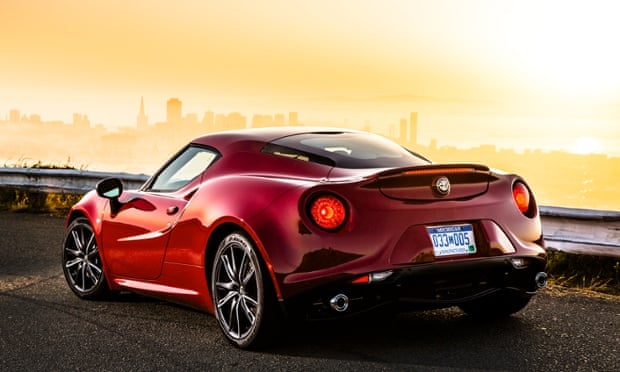 Into the sunset: the rear view of the 4C – what most of your fellow road users will see... Into the sunset: the rear view of the 4C – what most of your fellow road users will see... The engine burbles to life. The sound is amazing: a grunting, phlegmy clatter. On top of that the road noise is massive. At times it feels as if you are dragging a wooden dinghy up a shingle beach. Unassisted steering means it's hard to manoeuvre and almost impossible to park. But who cares, parking is for losers. And so you're off. Squeeze the throttle, in fact stamp on the throttle, and, bam, you find yourself in another world. The 4C is hungry, responsive, agile, wonderful. The acceleration is electric, the handling all-engrossing. It lives for the open road and the more you drive it the tighter it seems to fit around you. In many ways, it isn't happy unless you are doing at least 40mph. And you won't be happy unless you are doing more than that. Email Martin at martin.love@observer.co.uk or follow him on Twitter @MartinLove166 |
| Singapore Plans Driverless <b>Vehicles</b>, But You'll Have to Share | MIT <b>...</b> Posted: 22 Dec 2014 09:00 PM PST Singapore plans to let anyone test driverless cars in one of its busy neighborhoods in 2015. 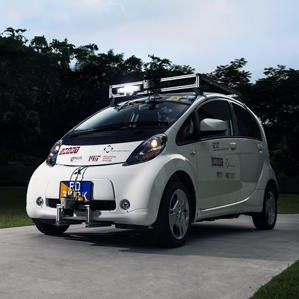 This electric car, retrofitted to drive itself, is being tested in Singapore. As driverless cars edge slowly toward commercial reality, some people are wondering how cities might change as a result. Will traffic lights disappear? Will parking garages become obsolete? Will carpooling become the norm? Singapore is keen to find out. The city-state will open one of its neighborhoods to driverless cars in 2015, with the idea that such vehicles could operate as a kind of jitney service, picking up passengers and taking them to trains or other modes of public transportation. The vehicles might be like golf carts, taking people short distances at low speeds, similar to the driverless vehicles demonstrated this year by Google (see "Lazy Humans Shaped Google's New Autonomous Car"). Lam Wee Shann, director of the futures division for Singapore's Ministry of Transport, said during a panel held at MIT last month that the government wants to explore whether autonomous vehicles could reduce congestion and remake the city into one built around walking, bicycling, and public transit. "Singapore welcomes industry and academia to deploy automated vehicles for testing under real traffic conditions on public roads," Lam said in a follow-up e-mail interview. He declined to say whether Google or any other companies pursuing driverless cars have contacted Singapore yet. At 700 square kilometers, Singapore is about three times the size of Boston, but it has 5.5 million residents versus Boston's 646,000. Because it is so dense, Singapore is aggressively trying to discourage car traffic. For example, if you want to own a car in Singapore you have to pay a "certificate of entitlement" fee that's roughly equal to the price of a car. It also offers free travel on city trains before peak periods (along with free breakfast vouchers). Through the Singapore-MIT Alliance for Research and Technology, the city has had pilot tests of driverless cars for several years, starting with two driverless golf carts on the campus of the National University of Singapore. This year it added a Mitsubishi i-MiEV electric car, retrofitted to be autonomous. A driverless bus called the Navia is used as a shuttle at Singapore's Cleantech eco-industrial park and on campus at Nanyang Technology University. All of these experiments "provide first-and-last mile connectivity to main public transport nodes," Lam said. This fall, people in Singapore were able to try out driverless cars for the first time. Driverless buggies were deployed in the Chinese and Japanese gardens in the Jurong Lake District. The system featured an online booking system and vehicle-to-vehicle communications. The buggies ran for two weekends, and carried 500 people over 400 kilometers in total. Cities with driverless cars could eventually eliminate mainstays like traffic lights. Paolo Santi, a senior researcher with the MIT/Fraunhofer ambient mobility initiative, said at the MIT event that his lab has done simulations showing that twice as many driverless cars could route themselves through intersections, easing congestion and reducing the greenhouse gas emissions caused by stop-and-go driving. Santi hopes to carry out experiments in Singapore to see how pedestrians and bikes affect driverless cars at intersections. Many challenges remain. On the panel at MIT, Nhai Cao, a senior global product line manager at TomTom, a navigation vendor, noted that, "current maps are not good enough for autonomous vehicles." Driverless cars, he said, need maps that are three-dimensional and accurate to within 20 centimeters. Lam also noted that if driverless cars are available to everyone, that could translate into more people taking car trips. "An autonomous vehicle could add on a lot more road trips, and we can ill afford that," he said. |
| Tesla Targeted By Rivals, Fuel-Economy Rule <b>Review</b>, Millennials <b>...</b> Posted: 29 Dec 2014 08:30 AM PST We're back from the long holiday weekend with plenty of green-car news, including a report on how Audi, BMW, Mercedes-Benz, and Porsche are targeting Tesla with their own plug-in cars, possible outcomes of an upcoming midterm review of Federal fuel-economy rules, and how Millennials are approaching car ownership. All this and more on Green Car Reports. Will the next-generation Lexus LS sedan feature a hydrogen fuel-cell powertrain option? Find out how gasoline cars parked in one electric-car spot earn Raleigh, North Carolina, $27,000 a year. See why gas stations can be hazardous to your health in many ways. We've got details on the Tesla Roadster 3.0 upgrade, which features a 70-kilowatt-hour battery pack and a claimed 400-mile range. A new report finds that Millennials own fewer cars than previous generations, and seek to live in places with more transportation alternatives. See all of the electric-car charging connectors on one big poster. The latest Congressional budget bill extended tax credits for electric-car charging stations and natural-gas fueling stations, but it also restored the "gas guzzler" tax deduction to its previous level. German electric-car charging station plans accelerate as the country's grid gets greener. Despite falling gas prices, ambitious Corporate Average Fuel Economy (CAFE) rules are expected to stay put through an upcoming midterm review. Audi, BMW, Mercedes-Benz, and Porsche all target Tesla with new plug-in cars. Yet another teaser video for the 2016 Chevrolet Volt surfaces. Last week, the Insurance Institute for Highway Safety (IIHS) released its annual list of safety ratings. Here are the biggest winners and losers. Finally, the Mazda LM55 Vision Gran Turismo concept carries the carmaker's Skyactiv line of fuel-saving features to the virtual world of video games. _______________________________________________ |
| A Prototype Battery Could Double the Range of Electric <b>Cars</b> Posted: 22 Dec 2014 09:00 PM PST Startup Seeo has developed batteries that store far more energy than conventional ones, which could extend the range of electric cars. 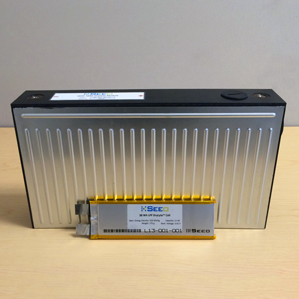 A flat, high-energy battery cell from Seeo, in front of a battery pack that contains many cells. An experimental lithium-ion battery based on materials developed at a U.S. Department of Energy lab stores twice as much energy as the batteries used in most electric cars. If the technology can be commercialized, it could give affordable electric cars a range of over 200 miles per charge, says Hal Zarem, CEO of Seeo, a startup that's working on the technology. Today the cheapest electric cars, which cost around $30,000, typically have a range of less than 100 miles. Alternatively, the improved storage capacity could be used to cut the size of battery packs in half while maintaining the current driving range, making electric vehicles considerably cheaper. A conventional battery pack with a range of 100 miles costs roughly $10,000. Seeo, which is based in Hayward, California, recently raised $17 million from investors, including Samsung Ventures. It plans to start shipping batteries to potential customers for evaluation next year. Seeo's prototype is what's known as a solid-state battery, meaning the liquid electrolyte used in conventional lithium-ion batteries is replaced with a solid one. Solid electrolytes have a number of potential advantages; the one Seeo has developed uses pure lithium, which allows it to store more energy. Other companies have developed batteries with solid electrolytes and pure lithium, but their energy storage capacity—at least for the large batteries needed in electric cars–has typically been less than what Seeo has achieved.  Seeo manufactures its batteries on conventional equipment. Normally, solid electrolytes don't conduct ions as well as liquid electrolytes. Also, pure lithium tends to form metal filaments, or dendrites, that cause short circuits. That problem is usually prevented by incorporating the lithium into another material, such as graphite. Seeo's solid electrolyte, however, contains two polymer layers. One is soft and conducts ions; the other is hard and forms a physical barrier between the electrodes, to prevent dendrites from causing short circuits. Other companies that have developed solid-state batteries with pure lithium have been forced to make changes elsewhere in the battery that decreased storage capacity, largely as a result of the voltage limitations of solid electrolytes. Seeo has been able to avoid that problem, though it's not giving details. Zarem says the batteries can be made using conventional equipment for manufacturing lithium-ion batteries, which could help keep costs down. Some key questions remain. Seeo doesn't yet know how many times the batteries can be recharged, for example. In an ongoing test, prototype cells have so far survived more than 100 charges, but to be practical they will need to last over 1,000 cycles. Another challenge is that existing lithium-ion batteries are quickly getting cheaper and better. By scaling up production of conventional batteries, Tesla Motors and Panasonic aim to produce electric cars that cost $35,000 and have a 200-mile range. |
| Fiat Panda 4x4: <b>car review</b> | Martin Love | Technology | The Guardian Posted: 15 Nov 2014 10:00 PM PST Price £14,295 I have a confession to make. I've lied to a priest. Father Dominic recently sent me an email from his church in Italy, in a village near Cortona, asking for advice about a car. I imagined him tapping away in the crypt of the ancient chapel, a guttering candle throwing shadows across the stone floor, the organist practising next door, a wild boar piglet snuffling in the straw at his feet… Anyway, the padre was after a vehicle that was both rugged and reliable at coping with the dreadful rural roads yet small and tidy enough to squeeze along the hill town's medieval streets. I figured he'd also need something Italian and that Pope Francis would approve of. Bugatti's Veyron and Maserati's Ghibli were out on the grounds of frugality and celibacy. There seemed to be only one candidate: Fiat's Panda 4x4. The problem was that I'd never tested one. Could I really recommend a car I'd never driven – to a priest? I figured God would understand. Weeks later I received an ecstatic email from the padre. He loved it and now wanted me to recommend a car for his mother… So I thought I'd better find out what Father Dom liked so much about the Fiat Panda 4x4. It first appeared in 1983. Back then, as the world's first small car to have all wheels driven, it was years ahead of its time. It shares the same boxy shape of the standard Panda, but the 4x4 is so much more than just a more agile Panda (if such a creature exists). It comes with steel bash plates to protect its delicate underside, chunky bumpers and high wheel arches to cope with its raised suspension, and a revolutionary electronic rear differential system that means it can roam wherever you want. Don't think of it as a weedy Land Rover – it's more a giant quad bike with a roof.  Funky and fun with comfort: the Fiat Panda's interior Funky and fun with comfort: the Fiat Panda's interior This model is the third generation of the car. It's as fun and funky as ever, but it now also has the quality, comfort and technology of a much more serious vehicle. It's hard to get your head around just how multi- talented it is: it seats five yet has a tiny road print; it's short and narrow yet has a high roof, so it feels roomy; its small engine is economical yet it's powerful enough to tow a caravan; it's built for rough tracks yet feels very at home on motorways. Under the bonnet there's a choice of an 875cc TwinAir Turbo or a 1.3-litre MultiJet 2 turbo diesel. Both come with start-stop technology and an indicator which tells you when to change gear in order to achieve the best economy. The car comes with "Dualdrive" electric power steering with a City function which means at slow speeds the steering is much lighter. An option you might want to invest in is a low-speed collision- mitigation system usually found only in much bigger cars. This reads the road ahead and when it detects an obstacle it slams on the brakes automatically. If you don't think you'll be needing the four-wheel drive system, the Panda Trekking model is for you: it has the same engines and chunky looks but is 2WD and £1,500 cheaper. Having spent a week with the Panda, I found it reliable when the going got tough, cheap to run and a lot cooler than you might guess… Everything you would hope to find in your local priest. 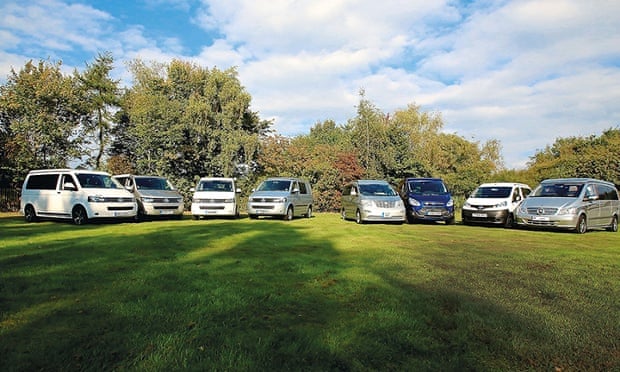 Eight of the best: the motorhome line-up. Photograph: PR Eight of the best: the motorhome line-up. Photograph: PR Earlier this summer I test drove the Wellhouse Ford Terrier SE and loved it. But I'm not the only one who has fallen for its charms. Which Motorhome, the UK's number one magazine for motorhome testing, has just completed an extensive group test of eight campervans, featuring four VW T5-based campervans and four key non-T5 alternatives. The VW T5 campervans featured were Bilbo's Space, CMC Reimo Trio Style White Line, Hillside Birchover and the Volkwagen California SE. The other campervans tested were the Auto-Sleeper Wave (based on Mercedes Vito), Hillside Dalbury Action (based on Nissan NV200), Wellhouse Alphard (based on Toyota Alphard) and Wellhouse Terrier SE (based on the Ford Transit Custom). The test team looked at campervans that gave almost equal priority to everyday use as they do to living outdoors. They were looking for compact dimensions and the ability to get under car park height barriers, plus minimal camping facilities including a small cooker, fresh water supply, beds and storage. The winner? Wellhouse's Ford Terrier SE, of course. Editor, Peter Vaughan said: "The VW T5 has dominated this sector to the degree that many customers simply say that they are looking for a Volkswagen camper. So for the Ford-based Terrier to come out on top speaks volumes about how good this campervan is." Which Motorhome is available from all good newsagents on the second Thursday of every month. For more information, go to which-motorhome.co.uk. Digital issues and subscriptions are available at pocketmags.com. Email Martin at martin.love@observer.co.uk or visit theguardian.com/profile/martinlove for all his reviews in one place. Follow Martin on Twitter @MartinLove166 |
| You are subscribed to email updates from car review - Google Blog Search To stop receiving these emails, you may unsubscribe now. | Email delivery powered by Google |
| Google Inc., 1600 Amphitheatre Parkway, Mountain View, CA 94043, United States | |

No comments:
Post a Comment